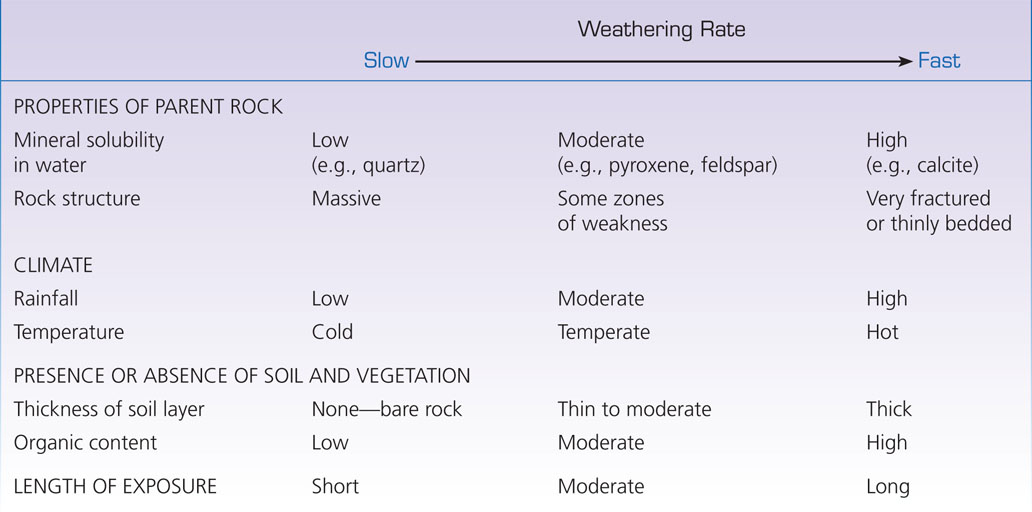Controls on Weathering
All rocks weather, but the manner and rates of their weathering vary. The four key factors that control rates of weathering are the properties of the parent rock, the climate, the presence or absence of soil, and the length of time the rocks are exposed to the atmosphere. These four factors are summarized in Table 16.1.

The Properties of Parent Rock
The mineralogy and crystal structure of parent rock affect weathering because different minerals weather at different rates and because a rock’s crystal structure affects its susceptibility to cracking and fragmentation. Old inscriptions on gravestones are evidence of the varying rates at which rocks weather. The carved letters on a recently erected gravestone stand out clearly from the stone’s polished surface. After a hundred years in a moderately rainy climate, however, the surface of a limestone monument will be dull, and the letters inscribed on it will have almost melted away, much as the brand name on a bar of soap disappears after a few washes (Figure 16.1). Slate or granite, on the other hand, will show only minor changes. The differences in the weathering of limestone and slate result from their different mineral compositions. Given enough time, however, even a resistant rock will ultimately decay. After several hundred years, a granite monument will also have weathered appreciably, and its surface and letters will be somewhat dulled and blurred.

437
Climate: Rainfall and Temperature
The rates of both chemical and physical weathering vary not only with the properties of parent rock, but also with the climate—especially the temperature and amount of rainfall—where that parent rock is located. High temperatures and heavy rainfall promote faster chemical weathering; cold and dry climates slow the process. Water in cold climates cannot dissolve minerals when it is frozen. In arid regions, water is relatively unavailable.
On the other hand, climates that minimize chemical weathering may enhance physical weathering. For example, freezing water may act as a wedge, widening cracks and pushing a rock apart. In temperate climates, the alternating freezing and thawing that accompany changes in temperature cause rocks to contract and expand, helping to break them apart.
The Presence or Absence of Soil
Although soil is itself a product of weathering, its presence or absence affects the chemical and physical weathering of other materials. Soil production is a positive feedback process—that is, soil formation advances more soil formation. Once soil starts to form, it works as a geologic agent to weather rock more rapidly. The soil retains rainwater, and it hosts a variety of vegetation, bacteria, and other organisms. The metabolism of those organisms creates an acidic environment that, in combination with moisture, promotes chemical weathering. Plant roots and organisms tunneling through the soil promote physical weathering by helping to create fractures in rock. Chemical and physical weathering, in turn, lead to the production of more soil.
The Length of Exposure
The longer a rock weathers, the greater its chemical alteration, dissolution, and physical fragmentation. Rocks that have been exposed at Earth’s surface for many thousands of years form a rind—an external layer of weathered material ranging from several millimeters to several centimeters thick—that surrounds fresh, unaltered rock. In dry climates, some rinds have grown as slowly as 0.006 mm per 1000 years.
438
Now that we have examined the factors that control rates of weathering, we can consider the two types of weathering—chemical and physical—in more detail.